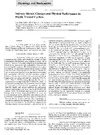Identificador persistente para citar o vincular este elemento:
https://accedacris.ulpgc.es/jspui/handle/10553/50995
| Título: | Salivary steroid changes and physical performance in highly trained cyclists | Autores/as: | Lopez Calbet, J. A. Navarro, M. A. Barbany, J. R. García Manso, Juan Manuel Bonnin, M. R. Valero, J. |
Clasificación UNESCO: | 241106 Fisiología del ejercicio | Palabras clave: | Salivary cortisol salivary testosterone anaerobic capacity cycling economy endurance training |
Fecha de publicación: | 1993 | Editor/a: | 0172-4622 | Publicación seriada: | International Journal of Sports Medicine | Resumen: | The purpose of this work was to study the seasonal salivary cortisol and testosterone changes, and their relationships with lean body mass variations, in highly trained cyclists. Physical fitness, body composition (6 skinfolds) and basal salivary testosterone were evaluated in 7 male cyclists, on two separate occasions. The first assessment was made at the onset of the competitive season and the second 6 months later. Two kinds of exercise tests were carried out. The first test was an incremental exercise test to determine the maximum O2 consumption (V̇O2max) and the maximum workload (Wmax). We also measured the V̇O2 and workload (W) attained at the first and second ventilatory thresholds (V̇O2 VT1, WVT1, V̇O2 VT2, WVT2). During the tests the V̇O2 was recorded every 30 seconds (Oxycon-5, Mijhardt BV, Odijk). As a second test two days later, we assessed the anaerobic capacity expressed as the maximal accumulated O2 deficit (MAOD). Briefly, each subject underwent five submaximal exercises each lasting 6 min at an intensity of 200, 220, 240, 260 and 280 W. We estimated individually the O2 demand by extrapolating the linear relationship between the power and the O2 demand previously established. Afterwards the subjects performed a supramaximal bout at an intensity producing exhaustion between 2 and 4 minutes. The accumulated O2 demand was calculated by multiplying the O2 demand by the supramaximal test duration. The MAOD was computed as the difference between the accumulated O2 demand and the O2 consumed during the supramaximal rides. We found a significant increase in some physical fitness parameters related to aerobic capacity. The Wmax increased from 5.7±0.5 to 6.1±0.3 W · kg-1 (p<0.05); the WVT2 increased from 3.6±0.5 to 4.0±0.5 W · kg-1 (p<0.05; the WVT2 increased from 4.4±0.6 to 4.9±0.4 W·kg-1 (p<0.05). The V̇O2max (from 75.7±4.8 to 75.3±3.5 ml · kg-1 · min-1, P = NS), the V̇O2 VT1 (from 51.7±6.2 to 54.1±5.3 ml·kg-1·min-1 P = NS), and the V̇O2 VT2 (from 62.5±7.2 to 65.1±3.4, p = NS) showed a non-significant increasing pattern. Nevertheless, the anaerobic capacity (expressed as the MAOD) decreased from 75.8±13.9 to 53.3±16.6 ml · kg-1 (p<0.05). The cycling economy, as reflected by the steady state V̇O2 at 240 W, ameliorated slightly (from 55.5±5.3 to 53.5±3.2 ml·kg-1 · min-1, p = NS), but the changes were non-significant. The subjects showed a significant decrease in weight (from 64.3±3.6 to 62.5±3.6kg, p<0.05) and in lean body mass (from 60.4±3.5 to 58.4±3.0kg, p<0.05). Salivary testosterone showed a non-significant decreasing pattern (from 0.45±0.17 to 0.39±0.18 nmol/l, p = 0.15). The testosterone/cortisol ratio decreased by 29% (from 0.022±0.010 to 0.016±0.005, p<0.10), but this change did not reach statistical significance. A firm correlation was found between increment of testosterone and increment of lean body mass (r = 0.87, p<0.05). Our cyclists increased their aerobic capacity, but they showed a deterioration of the anaerobic capacity. In spite of the high volume of exercise accumulated by these cyclists, the diminishing effect of endurance training on testosterone was not significantly evident. Our findings suggest that basal bioavailable testosterone changes are related to lean body mass variations. | URI: | https://accedacris.ulpgc.es/handle/10553/50995 | ISSN: | 0172-4622 | DOI: | 10.1055/s-2007-1021153 | Fuente: | International Journal of Sports Medicine[ISSN 0172-4622],v. 14, p. 111-117 |
| Colección: | Artículos |
Citas SCOPUSTM
27
actualizado el 08-jun-2025
Citas de WEB OF SCIENCETM
Citations
28
actualizado el 08-jun-2025
Visitas
143
actualizado el 01-mar-2025
Descargas
292
actualizado el 01-mar-2025
Google ScholarTM
Verifica
Altmetric
Comparte
Exporta metadatos
Los elementos en ULPGC accedaCRIS están protegidos por derechos de autor con todos los derechos reservados, a menos que se indique lo contrario.
